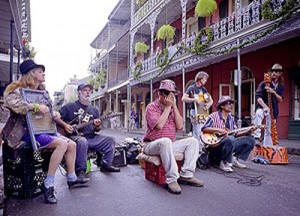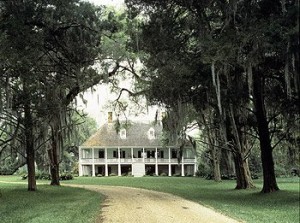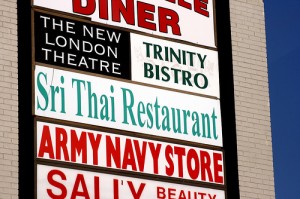Mississippi writer William Faulkner once remarked that in the American South, the past is never dead. It’s not even past. Defeated and largely impoverished by the nation’s Civil War a century-and-a-half ago, the South developed a distinctive culture that is studied and celebrated around the world.

Local bands play everywhere in New Orleans -- now. Fifty years from now? Who knows. (Carol M. Highsmith)
But that culture, which I soaked in with great pleasure for five years when I lived in the fabulous old seaport of New Orleans in the 1980s, has in many ways surrendered to the forces of global marketing, mass media, and in-migration from other regions and other nations.
Imagine that you have been blindfolded and dropped just outside a mid-sized southern city — say, Decatur, Georgia, or Gadsden, Alabama. Around you is a dizzying parade of fast-food outlets, national department stores, and banks that have branches in 30 states. It’s a scene that’s virtually identical to those in other cities across America. You could just as easily be in Pocatello, Idaho, except for the drier landscape.
Or say you turn on the television set in charming Charleston — South Carolina’s largest city — hoping to hear southern accents or Low Country music. Good luck. Unless you’ve tuned to the government-owned public station, the station is owned by a big national chain broadcaster, and the newscasters probably just moved in from Oklahoma or somewhere on their way up the broadcasting “food chain” of media markets.

Remnants of the Old South, such as Parlange Plantation in New Roads, Louisiana, are getting harder and harder to find. (Carol M. Highsmith)
Magnolia-draped cities such as Savannah, Georgia, and Charlotte, North Carolina — once a-flutter with ladies in swirling dresses and men sipping brandy on the veranda, “Gone With the Wind” style — are exemplars of the energetic “New South.” Their gleaming skyscrapers would fit just as comfortably in the skylines of Dallas, Texas, or Denver, Colorado.
So I would argue again, with at least a twinge of regret, that the languid, idiosyncratic South of Faulkner and Tennessee Williams, the South of twangy bluegrass and country stores, of backwoods storytelling and southern hospitality, of culinary eccentricities like goober peas and ground corn called “grits,” has been homogenized — even annihilated — by American mass culture.
And a lot of people right in the heart of the South agree with me.
Ted Smith, for instance, studies such things. An Arkansas native, he left a job as director of the southern cultural program in Vicksburg, Mississippi, to return to graduate school at the University of Mississippi. He told me:

Mall sign from New London, Connecticut, maybe? Bangkok? Nope. Snellville, Georgia. (quinn.anya, Flickr Creative Commons)
I think that there was obviously a rural way of life that is embedded in southern culture that has been lost, as people continue to be identified with cities that have more of the effect of a McDonald’s and mass-food chains and also cable television. I think you could look to direct-TV’s [satellite TV’s] importation into the rural South as something that would have a very powerful impact, especially on the children.
To amplify what he’s saying, imagine a crude backwoods farmstead, quite possibly one that has a shack for front-porch sittin’, a pump for water, and an outhouse for toilet facilities. It takes a lot of money and effort to bring not just running water, medical care, and the like, but also anything resembling sophistication into the boonies. Back in the hills and hollows, folks have, and quite often prefer, an amazingly isolated life.
Or they HAD such an existence. All you need are electricity and a few bucks a month to get a satellite dish into the remotest valley. It can expose the simplest of country folk to realms of knowledge and culture unimaginable a few decades ago. But that exposure — and the demand for the products and forms of entertainment available clear across the country — also diminish that valley’s unique if humble, once tightly guarded, place in the world.

Charles Reagan Wilson, a professor of southern studies at the University of Mississippi, ran the internationally renowned Center for the Study of Southern Culture on campus for much of the past decade. The center created a massive encyclopedia of southern traditions, folkways, and customs that will tell you everything — well, a lot — about everything from moon pies to boll weevils. (I’ll tell you, too, down in “Wild Words.”)
“We in the South sometimes tend to be way too interested in our own habits and ways,” Dr. Wilson told me one time. “I think that partly grew out of that sense of isolation and sometimes a sense of defensiveness. And so there certainly has been a tendency toward brooding upon ourselves.”
Dr. Wilson quoted the caustic Baltimore, Maryland, newspaperman H. L. Mencken, who wrote in the 1920s that “there is no culture in the South except the lower reaches of the gospel hymn.” Indeed, the South could not afford most of the affectations of high society such as symphony orchestras and ballet companies. But its working-class families developed some of the nation’s greatest folk art and oral history, jazz, early rock-‘n’-roll, and the blues.

Elvis, Jerry Lee Lewis, and other early rockers recorded at Sun Records in Memphis, Tennessee. (Carol M. Highsmith)
These days, Charles Reagan Wilson reminded me, many southern cities have fine museums and orchestras. Big recording studios in places like Nashville, Tennessee, have turned away from the twangy songs of Hank Williams and the honky-tonk tunes of Waylon Jennings in favor of blander mainstream performers with pretty voices and telegenic faces. Slick magazines like Southern Living write about raft trips and golf vacations, not just how to catch catfish or fry green tomatoes.
And the stream of northern retirees and other Yankees who are leaving the Rust Belt for the southern Sun Belt — not to mention the influx into the South of international corporations such as Mercedes and Siemens — continues unabated. They bring a culture — not necessarily a better one but a fresher, brisker-paced one — with them. A force for diversification, for more pluralism, they introduce new thinking, new attitudes, new ways of doing things into the section of America that was quite firmly set in its ways.
Like other towns across America, many southern communities believe it’s a status symbol — a cause for celebration — when big Wal-Mart department stores come to town. This worldwide mega-chain of 8,500 discount “big box” outlets began with a little store in the southern town of Rogers, Arkansas, and built its massive world headquarters complex in nearby Bentonville.

There are benefits — including lower prices, far greater merchandise selection, and a raft of new jobs — when such a retailer moves in. But there’s a loss as well, as distinctive local stores that had a southern identity suffer or close. “Sales,” Charles Reagan Wilson told me. “This is what is driving all this homogenization. Companies want to try to reach the largest market.”
And they’ll intrude into the tiniest of country hamlets to get those sales.
Yes, I know, “intrude” conveys a negative value judgment. Put me in the column of those who think homogenization comes at the great price of decreased local flavor, celebration of tradition, and even pride.
Dr. Wilson’s predecessor at the Center for the Study of Southern Culture, William Ferris, who now teaches at the University of North Carolina, told me not to fret. He’s not at all convinced that southern culture is but a memory. As he put it:
The South has never been a static, unchanging world. In many ways it has changed more radically than other parts of the country. When we think about slavery, civil war, civil rights, and now the growth of the Sun Belt, these are powerful changes.
And Dr. Ferris offered a reminder for those — like me, occasionally — who pine for genteel, dreamy days from a mythical southern past. (“Pine” the apt word choice. I can’t count all the country songs that describe the wind’s whistle through tall southern pines.)
“When we talk about southern heritage,” William Ferris reminded me, “let’s talk about whose heritage?”
We have to respect the black and the white, the rich and the poor, the men and the women. The South as we think of the “New South” is moving away from the symbol of the Confederate flag and of the old racial divisions, and creating a diverse ethnic and racial South that is going to be much healthier in the future.

A southern swamp that Carol captured in infrared, which turns natural green objects white. (Carol M. Highsmith)
What he’s pointing out is that some of those misty images of croaking frogs and mint juleps and moonlight through the Spanish moss aren’t so romantic to those who lived in the low reaches of stratified southern society.
Southern writers such as Eudora Welty often wrote about what they called southerners’ “sense of place” — an unbreakable connection to the rumpled hills, deep woods, and sweltering fields of their ancestors. Many southerners have told me that this grounding never fades, no matter where they go.
“A fish,” southern author William Penn Warren once wrote, “never thinks about water until he’s out of it.”
Against quite a bit of evidence to the contrary, in fact, cultural scholar Bill Ferris argues that, if anything, the South has influenced its surroundings even more than the world has changed the South.
Look at the electronic church [televangelists on TV]. The impact of blues. The impact of southern-based corporations like Coca-Cola [beverages], Federal Express [delivery services], Holiday Inn [motels], Wal-Mart [discount mega-stores], the CNN [broadcasting] worlds. It’s almost like kudzu creeping across the landscape of the world.

Kudzu is about to have its way with this rural bus stop. (Carol M. Highsmith)
Kudzu is a noxious vine, imported to protect the South’s sandy soil against erosion. Instead it went berserk, engulfing houses and fences and anything else standing still. And, insist scholars such as Bill Ferris, southern culture, like kudzu, has been tenacious in taking the South global.
He’s the expert, but I see it the other way around. I think northern and global ways have taken firm root all through the South. I saw it in New Orleans: Fast food in the heart of its incomparable culinary district. A softening and great dimunition of the city’s low-income “Y’at” accent in many parts of town. Corporate takeovers of what had once been idiosyncratic Louisiana oil, fishing, and wholesale food businesses. The loss of character, and locally bred characters, on local media.

Is the South changing? Contrast this aerial view of downtown Atlanta, Georgia, with the photo at the end of the blog. (kla4067, Flickr Creative Commons)
Not to mention the arrival of people like me, who move from the North and West into town, fall in love with the South’s folkways, but impose — imperceptibly at first and then with determination — our hurried pace and what we perceive to be our more urbane outlook on life.
In another couple of generations, I’m afraid, save for the humidity and touristy imitations of old customs such as Mardi Gras, there’ll be more New York — and maybe even New Delhi — than Louisiana Creole in Old New Orleans.
If that almost 300-year-old city can’t hold out against the homogenizing hordes, how do you think places like Pea Ridge, Alabama; Betsy Layne, Kentucky; and Due West, South Carolina will do?

The once-slow pace of southern life, personified. (Library of Congress)
Ted's Wild Words
These are a few words from this posting that you may not know. Each time, I'll tell you a little about them and also place them into a cumulative archive of "Ted's Wild Words" in the right-hand column of the home page. Just click on it there, and if there's another word that you'd like me to explain, just ask!
Boll weevil. A beetle with a drill-like mouth that devastated southern cotton crops until it was brought under reasonable control through the use of pesticides and traps baited with natural sexual-attractant hormones called “pheromones.” The “boll” part of the insect’s name is taken from the cotton plant’s seed pod.
Boonies. Usually referred to as “the Boonies,” this is short for “boondocks,” which in turn refers to remote, extremely provincial country. The word’s origin is unclear, although one theory is that American soldiers brought it back — Americanized from the Tagalog word bundok, meaning “mountains” — from their deployment in the Philippines during World War II.
Fret. To worry or express great discontent. As a noun, a fret is a ridge or bar on which strings pass and are separated on an instrument such as the violin.
Goober peas. Boiled peanuts — an old-time southern delicacy. So are peanuts dropped into an RC Cola, even though it leaves the soft drink flat and the peanuts soggy.
Moon pies. A snack that’s especially popular in the South, consisting of two round graham-cracker cookies and a marshmallow filling, all covered in a flavored (usually chocolate) coating. This fattening treat was first served to coal miners near Chattanooga, Tennessee, during World War I.
Y’at accent. A speech pattern heard in blue-collar sections of the southern seaport city of New Orleans that sounds more like Brooklyn than Basin Street. The name is taken from the local greeting, “Where y’at? Meaning, “What’s goin’ on?”


